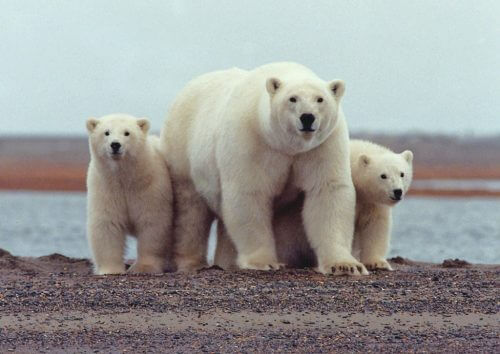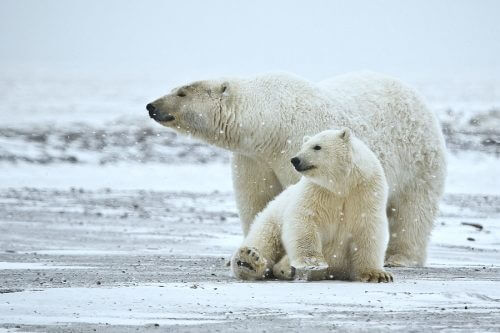New research reveals that polar bears are on the way to mass starvation

By Lior Mammon, Angle, Science and Environment News Agency
to the story of Knott, the German polar bear born in Berlin Zoo in 2006, has all the makings of a good contemporary Greek tragedy. Knut was the first German polar bear in thirty years to reach adulthood in captivity, but it was not easy. After his mother abandoned him and his brother died, Knut was raised by me Thomas Doralpin, the zoo worker, who raised him as his own, including sleeping together and lullabies by Elvis, which he would sing on an acoustic guitar until he fell asleep.
Little Knut, equipped with the appearance of a cloud of white cotton wool, became an international star overnight, and swept Germany in a storm that was later called "Knotmania". Knut appeared on the cover of the green issue of the German "Vanity Fair" magazine, which was dedicated to raising awareness of climate change and established Knut's status as the poster boy of the Arctic, even though he never lived there.
Since Knut's sudden death at the age of four, the condition of the polar bears has only continued to deteriorate, along with the small sea ice cover on which they depend exclusively for their sustenance. But desperate times call for desperate measures, and the new face that this time brings the polar bears' situation to the headlines is not equipped with a face as cute as Knut's button. In December 2017, polar bears made headlines again with the distribution of a video that went viral of a starving polar bear, as captured by National Geographic photographer Paul Nicklan inBaffin Island the canadian The heart-breaking spectacle of the ravaged bear in its last moments, falling into rusting cans left by the Inuit fishermen and collapsing in exhaustion moved and shocked many people in the world. Nicklan recorded the bear's slow death because he didn't want his death to be in vain. "The scientists say the polar bears are in danger, but I wanted people to see what it looks like. "The polar bears will starve to death, and this is what a dying bear looks like," he explained.
Accelerated process of decay
Just as the poles serve as an accelerated laboratory for global environmental climate changes, so the polar bears that are currently defined as vulnerable by the IUCN (International Union for Conservation of Nature) may experience an accelerated process of decline and deterioration following the damage and reduction of their natural and exclusive habitat. Polar bears are at the top of the food web, without any natural enemies, except of course man and his influence on the climate. The Arctic Circle serves as their exclusive habitat, and they often experience first-hand and in real time the impact of rising sea levels, warming temperatures and melting sea ice. And in these troubled days, when the sea ice at both poles is breaking New records of minimum coverage Every year, there is not much room left for optimism.
indeed, the antartics bers have developed during evolution sophisticated survival mechanisms that allow them to exist in extreme conditions, but they have become dependent onThe mercy of the thawing and freezing ice for their survival, and thus for more vulnerable compared to other mammals that are able to exist in diverse climate conditions. The main dish on Dobi's menu is seals high in fat, which the bears hunt directly from the ice, while they come up for air or to rest.
Besides their food supply, polar bears depend on the sea ice to expand their range of movement, to find mates, and to pass on life skills to the next generation. The freezing periods are the polar bears' window of opportunity to hunt and "prepare their bodies for the summer", which they spend on land, far from their seal snacks. Seals are much better swimmers, and bears are less likely to catch them when access to them is inconvenient. Climate change is causing the sea ice to melt and retreat earlier in the spring and freeze later in the winter, so the polar bears' summer fasting periods are getting longer each year, longer than they are used to or capable of.
New research Published at the beginning of February in the journal science tries to shed light on the way the bears' starvation mechanism really works, and the reason for it. The scientists followed the method generally accepted among dietitians and fitness trainers: closely monitoring the consumption and burning of the calories of polar bears.
The current study followed nine polar bears living in a sea zone Beaufort, part of the Arctic Ocean located north of Alaska and northwest of Canada. The study was conducted over ten days every spring for three years, in which the researchers took blood samples from polar bears, measured metabolic rate and other body parameters, followed one's daily activity patterns and hunting success rates in order to evaluate their energy balance.
The researchers were not satisfied with dry numerical measures, and attached collars equipped with GPS sensors and video cameras to the bears, as if they were participating in a particularly cool season of being "connected".

The research findings were more worrisome than the researchers thought. In order to survive, an average polar bear needs to consume a minimum of 12 calories a day (which should be provided by a medium-sized adult seal once every 10 days, or three adult seals or 20 tiny and fluffy seal pups, or 220 Big Macs in a branch the upcoming "McDonald's Alaska"). However, a decrease of about 14 percent in sea ice cover within a decade makes the seals more difficult to reach. During the study, the bears that succeeded in hunting seals maintained their weight, but more than half of the remaining bears, forced to subsist on scraps, lost up to a tenth of their total weight.
Waste too much energy
If it's not enough that food availability has decreased, the study also found that the metabolic rate of the bears is higher than previously thought. The bears burn a lot of energy when they walk, 1.6 times more than previous estimates, and they spend almost a quarter of their time walking in the endless expanses of ice. As a result of the thaw, the ice surfaces become fragmented and disintegrated in the spring, thus increasing even more the walking distances that the bears have to cover in order to find food. The routine of life in the North Pole is already very demanding, and if the energy required to find food is too high for the bears to withstand, this may lead to an increase in mortality rates and a reduction in their population. According to the simple calculation of the researchers, together with the predicted global warming, the polar bears are expected to spend more and more energy, while they consume less and less. You don't have to be a mathematician to understand that this continuous state of energy deficit will end in starvation.
"Today there are between 25-30 thousand polar bears living in the wild in the Arctic region, this after their population recovered following the signing of an international agreement to reduce hunting and protect polar bears in 1973, signed by, among others, Canada, the USA, the USSR , Norway and Denmark," says Dr. Adi Levy, the scientific director of the Israeli Association for Ecology and Environmental Sciences. "Despite the agreement, due to the climate change that manifests itself in an accelerated manner at the poles and leads to the shortening of the sea ice season and the reduction of its area, a third of the polar bears may disappear by the year 2050."
Levy adds that "the sea ice allows the bears to hunt relatively easily, but the more those bears require to spend more energy in search of food, in swimming longer distances between glaciers or in walking on land, the availability of their favorite food will decrease (the seal of the species Ringed seal -Pusa hispida, but also pods and beluga whales) and they are expected to suffer from a greater lack of food and ever-increasing mortality rates."
